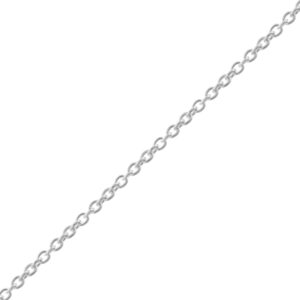Trace chains are made in much the same way as the simpler chain designs like Cable or Belcher chains. Links of uniform breadth and thickness, usually small and oval in shape, are joined together one after the other to form a chain.
The origin of this chain’s name is unknown though a couple of theories and connections do exist. The first two are etymological with the word itself referring to how small and fine the chain is, as in “trace of (a) chain”, or alternatively how each link traces and follows the next in the sequence. The other theory is that like the Curb chain, the Trace chain has an equestrian root and was originally one of the many chains used to harness horses and similar animals to farm equipment or carriages. As there is not a direct link here the usage is probably just coincidence and the real origin is more likely connected to the word itself.

Although the Trace chain is by all means a simple chain in design, its definition is slightly complicated as some jewellers refer to any style of chain below a certain thickness or width threshold as a trace chain rather than a single specific design. Using this definition, the trace is not its own style of chain but just a subcategory of another style. Very little separates Trace chains from smaller versions of other chains, as they are in essence the same design but scaled down. For the sake of simplicity, it can be easier to refer to all smaller and very fine chains as trace because the unique designs which define these chains are sometimes lost when made this small. The actual design of the trace chain depends on which other chain it is based on, which also means it carries the same properties as them as well. This means that you can have trace versions of cable, curb or even Figaro chains.
By definition they are not found in larger sizes so the uses are limited. Used to fill out or accentuate other chains worn arranged in a sequence or layered around the neck or wrists with other chains. Trace chains can also be found diamond cut for a small eye-catching chain with a sparkle. The most common use for the Trace chain however is as an inexpensive and simple option for hanging charms and pendants as the size means most pendant loops or bails will fit this type of chain. But because they are so small the chains do not weigh very much and can’t withstand particularly heavy weights. The minute widths and fine nature also means that these chains can easily tangle which is something to bear in mind when wearing or storing these chains. But if you’re looking for a lightweight, reliable and cost-effective chain that still looks good, then you can’t go far wrong with a Trace chain.

